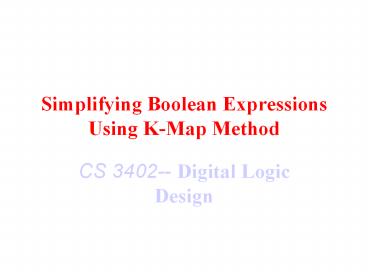Simplifying%20Boolean%20Expressions%20Using%20K-Map%20Method PowerPoint PPT Presentation
Title: Simplifying%20Boolean%20Expressions%20Using%20K-Map%20Method
1
Simplifying Boolean Expressions Using K-Map Method
- CS 3402-- Digital Logic Design
2
Simplifying Switching Functions
- SOP and POS expressions
- gt 2-level circuits
- Minimum SOP/POS expression
- Minimize the number of literals
- Minimum number of terms
- How?
- Algebraically I.e. using the axioms and theorems
of Boolean algebra. - Karnaugh Map
- McCluskey Method
3
Simplifying Algebraically
- Simplify F(X,Y,Z) X YZ XYZ XYZ
- Simplify F(A,B,C) ABC ABC ABC
4
Simplifying Switching Functions K-Map
- Simplifying Theorem
- XY XY Y
- Definition Logical Adjacency
- Two terms are logically adjacent iff they differ
in only one literal the literal is complemented
in one term and non-complemented in the other. - Two Logically adjacent terms can be combined into
one term consisting of only the common literals
5
Simplifying Boolean Expressions
- Example XY XY
- ABC ABC
- ABCD ABC
- (AB CD).(ABCD)
- AB AB
- ABC ABC
- (XY) (XY)
6
Karnaugh-Map (K-Map)
- 2-dimensional representation of a truth table.
- Logically adjacent terms are physically adjacent
in the map. - 2-Variable Functions F(X,Y) XY XY
X Y
F(X,Y)
0 0 0 1 1 0 1 1
m0 m1 m2 m3
7
2-Variable K-Map
XY
XY
XY
XY
- Note
- Logically adjacent cells are physically adjacent
in the k-map - Each cells has two adjacent cells
m0
m2
m1
m3
8
Function Minimization Using K-Maps
- 1. Each square (minterm) in a k-map of 2
variables has 2 logically adjacent squares, each
square in a 3-variable k-map has 3 adjacent
squares, etc. - 2. Combine only the minterms for which the
function is 1. - 3. When combining terms on a k-map, group
adjacent squares in groups of powers of 2 (I.e.
2, 4, 8, etc.). Grouping two squares eliminates
one variables, grouping 4 squares eliminates 2
variables, etc. - Can't combine a group of 3 minterms
9
Function Minimization Using K-Maps
- 4. Group as many squares together as possible
the larger the group is the fewer the number of
literals in the resulting product term - 5. Select as few groups as possible to cover all
the minterms of the functions. A minterm is
covered if it is included in at least one group.
Each minterm may be covered as many times as it
is needed however, it must be covered at least
once. - 6. In combining squares on the map, always begin
with those squares for which there are the fewest
number of adjacent squares (the loneliest"
squares on the map).
10
Definitions
- Implicant a product term that could be used to
cover one or more minterms - Prime Implicant A product term obtained by
combining the maximum number of adjacent squares
in the map. - Essential Prime Implicant A prime implicant
that covers at least one minterm that is not
covered by any other prime implicant. - All essential prime implicants must be included
in the final minimal expression.
11
Definitions (Cont.)
- Cover of function is a set of prime implicants
for which each minterm of the function is covered
by at least one prime implicant. - All essential prime implicants must be included
in the cover of a function.
12
Algorithm for Deriving the Minimal SOP
- 1. Circle all prime implicants on the k-map
- 2. Identify and select all essential prime
implicants - 3. Select a minimum subset of the remaining prime
implicants to cover those minterms not covered by
the essential prime implicants.
13
Four Variable K-map
14
Five Variable K-map
15
More Examples
- Find min. SOP and POS expression for each of the
following functions - F(A,B,C,D) ? m(2,3,5,7,10,11,13,14,15)
- G(W,X,Y,Z) ? M(1,3,4,5,7)
- H(A,B,C,D) ?m(1,3,4,7,11)d(5,12,13,14,15)
- F2(A,B,C,D) ? m(1,2,7,12,15)d(5,9,10,11,13)
- F3(A,B,C,D,E) ? m(0,1,2,4,5,6,13,15,16,18,22,24,
26,29)

